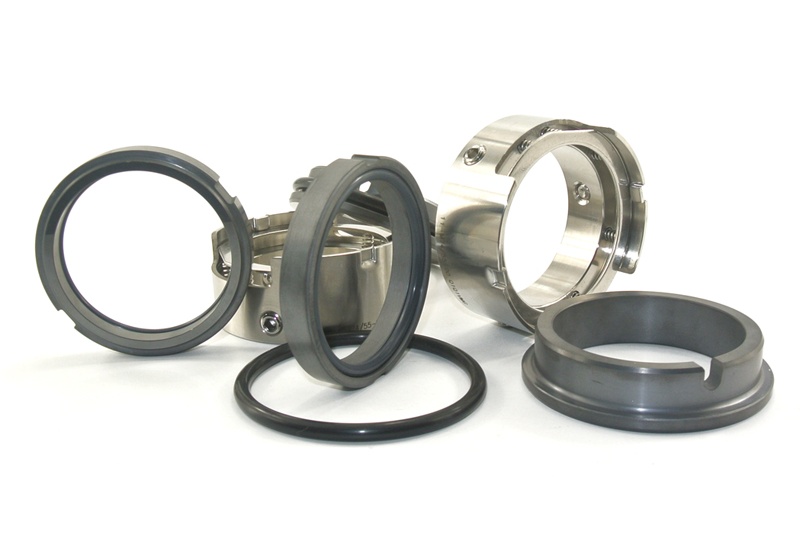News
A2024-12-23

Mechanical seals are key components commonly used in industrial equipment and are widely used in rotating equipment such as pumps, compressors, and agitators to prevent medium leakage and intrusion of external impurities. Correct removal, installation, selection, and use of mechanical seals are essential for the normal operation of the equipment. This article will introduce the relevant knowledge of mechanical seals in detail and provide operating guidelines.
1. Basic knowledge of mechanical seals
Definition of mechanical seals
A mechanical seal is a device that relies on one or more pairs of dynamic and static rings perpendicular to the axis to fit each other, and achieves sealing through auxiliary seals. It can effectively prevent fluid leakage and has a long service life.
Composition of mechanical seals
Mechanical seals are usually composed of the following parts:
Dynamic ring: rotates with the shaft and cooperates with the static ring to form a sealing end face.
Static ring: fixed on the equipment housing, and cooperates with the dynamic ring to achieve sealing.
Spring: provides initial pressure to make the dynamic ring and static ring fit tightly.
Auxiliary sealing ring: used to prevent fluid leakage from axial or radial directions.
Transmission mechanism: transmits the rotation of the shaft to the dynamic ring.
Classification of mechanical seals
Classification by structure: single-end seal, double-end seal, multi-end seal.
Classification by medium pressure: internal seal, external seal.
Classification by sealing medium: dry gas seal, liquid seal, gas seal.
2. Disassembly operation guide of mechanical seals
Preparation
Turn off the power of the equipment and empty the medium in the equipment.
Prepare disassembly tools, such as wrenches, screwdrivers, rubber hammers, etc.
Wear necessary protective equipment, such as gloves and goggles.
Disassembly steps
Disassembly of static ring: first loosen the static ring fixing bolts, carefully remove the static ring and auxiliary sealing ring to avoid damage to the sealing surface.
Disassembly of dynamic ring: loosen the fastening bolts of the dynamic ring transmission mechanism, and remove the dynamic ring from the shaft.
Cleaning and inspection: After disassembly, check the wear of the sealing surface, clean the seals and related parts.
Precautions
Avoid using hard objects to hit the seals during disassembly to prevent damage to the sealing surface.
Properly store the parts after disassembly to prevent loss or contamination.
3. Installation and operation guide of mechanical seals
Preparation
Clean the shaft, housing and seals to ensure that there are no impurities and damage.
Prepare lubricants (if necessary), such as silicone oil or special grease.
Installation steps
Install the static ring: gently press the static ring into the housing to ensure that the static ring fits tightly with the housing, and tighten the fixing bolts evenly.
Install the dynamic ring: put the dynamic ring on the shaft to ensure that the dynamic ring and the shaft fit well, install the transmission mechanism and tighten the bolts.
Install the auxiliary sealing ring: install the auxiliary sealing ring on the shaft or housing to ensure that the sealing ring is not twisted or damaged.
Precautions
Avoid contact between the sealing surface and hard objects or foreign objects during installation to prevent scratches.
Use uniform force when tightening the bolts to prevent uneven force on the seal.
4. Selection guide of mechanical seals
Select according to the medium
Select corrosion-resistant, high-temperature-resistant or wear-resistant sealing materials according to the properties of the sealing medium (such as acidity, alkalinity, corrosiveness, viscosity, etc.).
Common materials: silicon carbide (wear-resistant), graphite (high-temperature-resistant), fluororubber (corrosion-resistant).
Select by pressure
Double-face seal or multi-face seal is selected for high pressure occasions.
Single-face seal is selected for low pressure occasions.
Select by temperature
Select high-temperature resistant materials for high-temperature occasions and consider cooling devices.
Select low-temperature resistant materials for low-temperature occasions and prevent material embrittlement.
Select by speed
Select balanced seals for high-speed rotating equipment to reduce friction and wear.
Unbalanced seals can be selected for low-speed equipment.
V. Use and maintenance of mechanical seals
Precautions for use
Check whether the seal is installed correctly before starting to ensure no leakage.
Pay close attention to the vibration and temperature of the equipment during operation, and stop the machine for inspection in time if abnormalities are found.
Maintenance and maintenance
Check the wear of the seal regularly and replace it if necessary.
Clean up impurities and sediments in the seal cavity regularly.
Replace lubricants or coolants regularly to ensure that the seal is in good working condition.
Troubleshooting
If leakage is found, check whether the sealing surface is worn or the auxiliary seal ring is damaged.
If the equipment vibrates too much, check whether the shaft is poorly aligned or the seal is loose.
VI. Summary
The removal, installation, selection and use of mechanical seals are key links to ensure the normal operation of the equipment. Through the operation guide in this article, users can better master the relevant knowledge of mechanical seals, extend the service life of the equipment and reduce the failure rate. In actual operation, it should be flexibly applied according to the specific conditions of the equipment to ensure that the performance of the mechanical seal is fully utilized.
[DLSEALS kindly Reminder] Sealing issues? Turn to DLSEALS! As a sealing component manufacturer, we specialize in customizing sealing components, providing a full range of services from design, research and development, production, testing, and more. If you have more information you'd like to know, feel free to contact us directly. DLSEALS's product experts are dedicated to serving you!